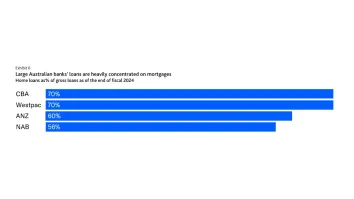
6 key takeaways from China Construction Bank's FY12 results
2013 NIM is expected to be at the 2011 level of 2.7%.
Here are Barclays' key takeaways from CCB's post results analyst briefing:
1) 2013 NIM expected to be at 2011 level (2.7%),
2) asset quality to stay stable,
3) more non-principal guaranteed wealth management products to be issued going forward,
4) reduced LGFV exposure,
5) slightly loan RMB growth in 2013, and
6) prudent capital management.
Here's more from Barclays:
2013 NIM expected to be at 2011 level (2.7%): CCB’s management said that two rate cuts and interest rate deregulation in 2012 had negative impact on the bank’s NIM. Since 4Q12, the bank’s re-priced assets have surpassed re-priced liabilities, which triggered NIM contraction.
Management expected that the NIM for 1Q13 could decline several percentage points q/q and the overall NIM in 2013 could return to 2011 level of 2.7% from 2.75% in 2012.
Management also claimed that only 3-5% of the bank’s clients can have 1.1x benchmark deposit rates at this moment. The bank will allow more clients to have above-benchmark deposit rates on a differentiated strategy, but it plans to contain this portion of clients.
Slightly slower loan growth: The bank plans to grow its domestic RMB loans by 12% in 2013 (slightly down from 13.5% in 2012). The net increase in loan amount should be higher this year. Domestic FX loans will grow at a fast pace this year.
Asset quality to keep stable: CCB said it followed prudent NPL classification. Management advised that 1) the Zhejiang area has the highest NPL and overdue loan growth with Wenzhou and Hangzhou contributing 75% to Zhejiang’s NPLs and overdue loans and
2) manufacturing and retail & wholesales industries have higher credit risks than others. In 2013, NPL risks in Zhejiang area seen to have stabilized, according to the management.
Management said that the bank currently has no lending to Suntech - peak time exposure was RMB 600m credit line borrowing in 1H11 and CCB completed got out since then.
Regarding areas with potential high risks in 2013, management pointed out that companies with negative cash flow, high leverage and export-oriented businesses could have higher credit risks than others.
CCB said that it would maintain its credit charge at about 0.45%-0.5% in 2013.
Reduced LGFV exposure: Both of the bank’s LGFV loan balance and number of LGFV customers declined in 2012. NPL amount was only RMB 1.7bn at end-2012 (down by RMB 3.6bn y/y).
The special mentioned loan amount was RMB 25bn at end-2012, which declined by RMB 10.3bn y/y. 97% of the LGFV loans were fully or generally covered by cash-flows (up from 89% at end-2011).
According to CBRC’s classification, 70% of CCB’s LGFV loans were under ‘support’ category, 25% under ‘maintain’ category, and only 5% was under ‘reduce and exit’ category.
More non-principal WMPs to be issued in 2013: Management mentioned that CCB increased its principal guaranteed wealth management products in 2Q12 and 3Q12 due to strong demand from central and local SOE clients who can only buy principal guaranteed products by government regulation.
The SOEs demands have largely be met in 2012, and recently demand from other clients have grown more strongly, where the preference is for non-principal guaranteed products with high return. Going forward, the bank is to provide more non-principal guaranteed WMPs.
In terms of risk management, CCB said that it has strengthened the risk control and monitoring on its WMPs and trust products, including increasing the collaterals. Overall, risk on WMPs and trust products is manageable.
Prudent capital management: According to the management, CCB does not need any capital replenishment in the next 2 to 3 years. But from a more prudent capital management perspective, CCB announced a RMB 60bn new capital raising plan (including a RMB 40bn sub-debt issuance plan), and the bank is actively studying new capital tools. The new capital rules should have some small negative impact on CCB’s CAR.
The bank has already officially submitted the requirement to use internal ratings-based approach (IRB approach) for credit risk calculation, once approved by the CBRC, it will have some capital saving effect on the bank.
However, there is a 5% cap for the difference of calculated credit risk-weighted amount under IRB approach and standardized approach in the first year of applying the IRB approach, the cap will be lifted to 10% in the second year of applying, and removed from the third year onwards.



















 Advertise
Advertise










